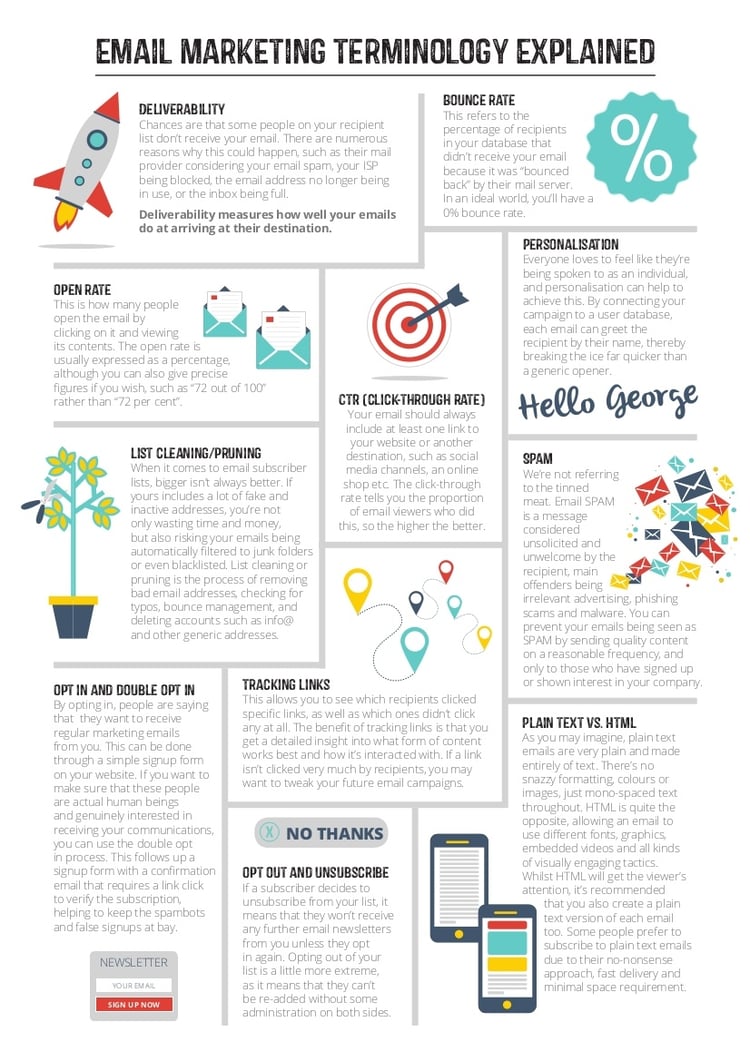
Email marketing isn’t dead; in fact, it’s anything but. A good, well-crafted email can capture a consumer’s attention and nurture them in a way that keeps you top of mind and, eventually, encourages them to buy from you. However, using email marketing in your business is much more than continuously spamming subscribers with emails because they’ll stop opening them or unsubscribe–losing that person to you forever.
Email Marketing Glossary Made Easy

Trying to make sense of email marketing begins with learning all the terminology and jargon associated with it.
The jargon is intense, and it’s important to get the basics right as there are many terms with legal implications and others that represent trends and best practices. In order to help you become a better email marketer, here’s a list of email marketing terms to get you started.
ESP – Email Service Provider
To start off with, you need an ESP. Think Mailchimp, ActiveCampaign, ConvertKit, AWeber, and more. An email service provider is essentially a software service that facilitates the sending of email marketing campaigns to subscribers for the business. A good ESP can host email marketing services for innumerable clients and businesses, worldwide. Email service providers should –
- Create and maintain email subscriber lists
- Provide customizable email templates
- Send emails either manually or automatically
- Give you detailed campaign analytics
- Allow for testing
- Permit dynamic content and give personalization options
- Give you capabilities like list segmentation and more
Email Automation
Automation is a key factor in saving time with your email marketing and enabling you to customize content based on what your subscribers are looking at on your website. Automation refers to the features that help email marketing software send campaigns to customers according to certain predefined settings. For example, how much money a subscriber spends, whether they make a purchase, etc., will impact what emails they receive from you. Marketing automation is great because it gives email marketers the opportunity to reach more customers in a targeted and personalized way.
Click-Through Rate
This metric measures how many people have clicked on an image, hyperlink, or the call to action button in an email. Measuring the CTR is an effective way to determine just how good an email is. CTR rates may vary, but a rate between 20% and 30% shows an email is doing very well. If CTR rates fall below this range, you may want to change up your emails to encourage more clicks. Any good email service provider should give you consistent reports about your CTRs so you can carry out the necessary modifications to your email campaigns.
Hard Bounce
This happens when an email is returned to a sender for permanent reasons, such as the email wasn’t deliverable because it used an incorrect domain name, an incorrect email address, or the recipient is unknown or not real. Hard bounces can affect deliverability rates which is why you need to remove invalid email addresses as soon as possible. Any email service provider should be able to remove hard bounces from your email subscription list.
Soft Bounce
This is similar to a hard bounce, but the difference is that in the case of a soft bounce, the email is not delivered due to temporary reasons. This happens either because of the large file size or if a recipient’s inbox is full. They aren’t as bad as hard bounces, because your ESP will try to re-send these soft bounces automatically. However, if the emails continue to bounce, it is worth it to look further into the issue.
Acceptance Rate
This refers to the emails that are accepted by your recipient’s email servers. Also known as deliverability rate, this is a good way to check whether the emails are being delivered or are bouncing back. This doesn’t tell you whether the email made it to the recipient’s inbox or spam folder.
CAN-SPAM
According to the Controlling the Assault of Non-Solicited Pornography and Marketing Act (CAN-SPAM) of 2003, all businesses need to follow strict guidelines while engaging in email marketing campaigns. The CAN-SPAM rules are enforced by the Federal Trade Commission, or FTC, which specifies that all recipients should easily be able to unsubscribe from your mailing list, as well as other rules.
Sender Score
Your sender score refers to your IP address’s reputation, scored on a scale of 0 to 100. This operates similarly to a credit score, and the higher your sender score, the more reputable your IP is considered. Email services depend on this score to determine what emails make it to recipients’ inboxes and which ones don’t.
The A/B Split Test
This method compares the results of two different emails and gives you a detailed analysis. Suppose you prepare two or more variants of an email, and name them A, B, C, etc. You can then send it to different people and compare results, to find out which email is the most impactful. Usually, the test compares two different subject lines, however, you can also change up the format or call to action inside the email to compare success. The trick is that you choose one variable to test in the emails.
Multivariate Testing
This refers to testing different variables in an email to see what works best. The email content, images used, font, offers mentioned, all matter toward making a successful email. Marketers can use multivariate testing to see which combination suits them best. This is different from A/B testing in that multivariate testing includes many variables. For instance, if you have one test email with a Times New Roman font, and one CTA while another has a better font like Calibri, and two CTAs, the tester can find out which one of these is more effective at achieving a better CTR.
Email Harvesting
Email harvesting is when a user procures a list of email addresses that have similar interests to send a mass email. Special harvesting tools make this job easier. However, many countries have deemed this illegal, so marketers may need to check before implementing it.
Transactional Email
This is an automated email that is triggered by a purchase. This is significant because these emails are opened much more often than traditional marketing messages. High-end ESPs allow users to create, edit and optimize transactional emails so they’re customized to exactly what you want to deliver to your new customer. A simple example is a thank you email after a purchase, or a follow-up discount coupon.
List Segmentation
List segmentation is simply the act of personalizing your contact list and separating it into distinct groups or categories. Usually, these segments fall in the same phase of the email funnel, and this can help a user send more targeted and relevant content to their subscribers.
Double Opt-In
To ensure you get only genuinely interested subscribers, you can utilize the double opt-in. If a user chances upon your website blog and signs up for your newsletter, you can ask them to verify their email address by sending them a test. This helps keep your list clear of uninterested subscribers, but it also makes it more difficult to grow your email list.
Sender Policy Framework
This email-authentication technique helps marketers avoid spammers from sending emails on another domain’s behalf and helps with domain authentication. Certain filters show that your email is not spam, and serves a specific purpose.
HTML Tags
Tags inside your emails can help you personalize your emails for individual recipients. For example, if you use the tag <firstname> in your email, and send it to your list, it automatically writes each individual’s name on each email. Most email providers offer this, however, you have to ensure that you’re collecting this information from subscribers.
Conclusion
Email marketing is a classic that has been around for a long time and will continue to be a safe bet in the future’s fast-paced digital marketing world. Read our blog on the resurgence of email newsletters, to see how they stack up against social media as an effective form of communication.
